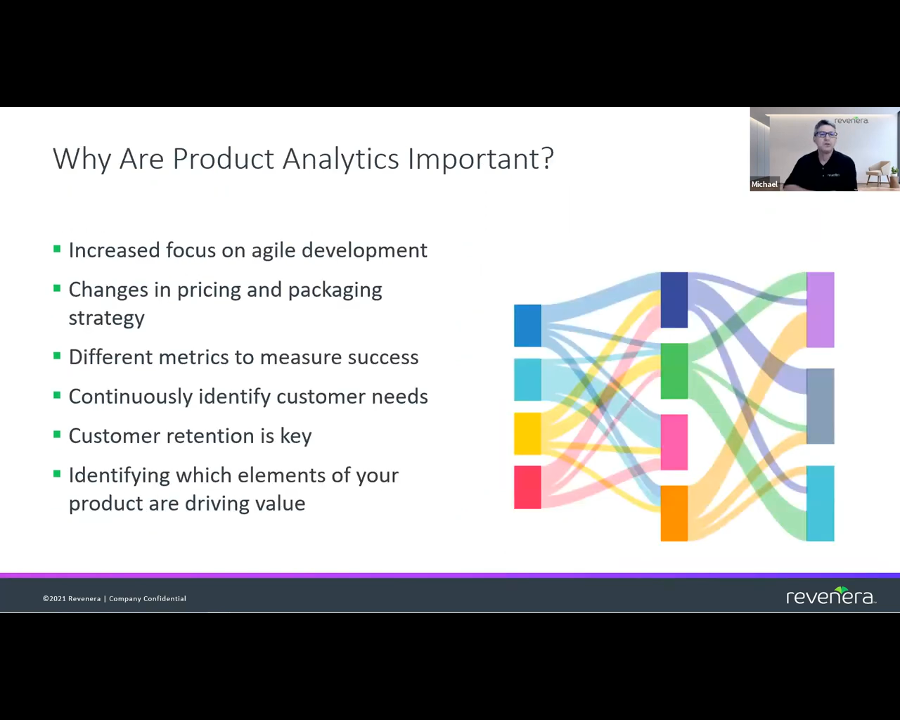Webinar
Software Usage Analytics for Desktop Applications
Learn how desktop software vendors use product analytics to drive roadmap, pricing, and SaaS strategy decisions.
Original Air Date: June 21, 2021
Overview
If you're a software producer navigating the complexities of desktop applications in a SaaS-driven world, this webinar is a must-watch. Join Daniel Barrett, Solution Engineer, and Michael Goff, Principal Product Marketing at Revenera, as they unpack how software usage analytics can transform your product strategy.
You'll learn how to uncover hidden user behaviors, identify which features drive the most value, and make smarter decisions about pricing, packaging, and roadmap prioritization. Whether you're maintaining legacy on-prem products or planning a SaaS migration, this session offers practical insights to help you stay competitive. Discover how leading vendors are using data to improve customer retention, accelerate trial conversions, and optimize user experience.
Real-world examples, including a case study from TechSmith, show how analytics can drive measurable business outcomes. Plus, you'll get expert guidance on whether to build or buy your analytics solution—and how to get started quickly. If you're ready to monetize what matters and deliver more value to your users, this webinar will show you how.
Recap
Key Themes and Takeaways
Why Desktop Usage Analytics Still Matter
Despite the growing dominance of SaaS, desktop applications remain a vital part of many software vendors’ portfolios. Michael Goff emphasized that while SaaS revenue is increasing, on-prem software is far from obsolete. Many vendors are maintaining or even expanding their desktop deployments, making it essential to understand how these products are being used to stay competitive and make informed decisions.
SaaSification and Hybrid Deployment Trends
The webinar explored how vendors are adapting to the shift toward SaaS, with many adopting hybrid models. A live poll revealed a balanced mix of on-prem, SaaS, and hybrid deployments among attendees. This underscores the importance of usage analytics across all environments, especially as customer expectations evolve to demand continuous updates and transparency—even from desktop products.
The Value of Usage Data in Product Strategy
Daniel Barrett and Michael Goff demonstrated how usage analytics can uncover which features are most valuable, which are underused, and how different user personas engage with the product. These insights help product teams prioritize development, refine pricing and packaging strategies, and align roadmaps with actual user behavior.
Real-World Use Case: TechSmith
A standout case study from TechSmith showed how usage analytics can drive measurable business impact. By identifying unexpectedly popular features and localizing survey outreach, TechSmith improved user experience and dramatically increased survey response rates. Their product, marketing, and sales teams all leveraged the data to enhance engagement, conversion, and retention.
Build vs. Buy: Choosing the Right Analytics Solution
The speakers discussed the trade-offs between building a custom analytics solution and adopting a turnkey platform. While building offers flexibility, it demands significant engineering effort. Turnkey solutions like Revenera’s Usage Intelligence are designed for fast implementation—typically just a few developer days—making it easier to start collecting meaningful data without heavy resource investment.
Crawl-Walk-Run: A Practical Approach to Implementation
Attendees were encouraged to start small by tracking the most critical features first, then expanding over time. This phased approach prevents data overload and ensures that insights are actionable. Most of the effort should go into planning what to track, not coding, allowing teams to iterate and mature their analytics programs effectively.
Overcoming Internal Resistance and Driving Adoption
One audience question focused on how to get internal teams excited about usage data. Michael Goff recommended aligning analytics insights with each department’s goals—such as churn reduction for sales, messaging optimization for marketing, and roadmap validation for product management. Sharing metrics regularly across teams helps build momentum and cross-functional buy-in.
Segmenting Users for Better Feedback
Usage analytics enable smarter customer feedback collection by identifying who is most engaged or who hasn’t discovered key features. This segmentation allows for targeted surveys and interviews, improving the quality of insights and helping teams understand both power users and those at risk of churn.
Speakers

Daniel Barrett
Solutions Engineer
Revenera

Michael Goff
Principal Product Marketer
Revenera
Frequently Asked Questions
Software usage analytics refers to the tracking and analysis of how users interact with a software application. It helps software producers understand which features are used most, how users navigate the product, and where they may be dropping off. This data is critical for making informed decisions about product development, pricing, and customer engagement. For desktop applications, usage analytics can be especially valuable since traditional tracking methods are less common compared to SaaS products.
By identifying which features are most frequently used and which are underutilized, product teams can prioritize enhancements that deliver the most value. Usage data reveals real user behavior, helping teams avoid relying solely on assumptions or anecdotal feedback. This leads to more targeted development efforts and better alignment with customer needs. It also helps determine which features to migrate first when transitioning to SaaS or hybrid models.
Tracking feature usage in desktop applications allows software producers to understand user engagement at a granular level. It helps identify sticky features, discover unused functionality, and segment users based on behavior. These insights can inform UI improvements, training resources, and even monetization strategies. Without this data, teams risk investing in features that don’t drive value or missing opportunities to enhance the user experience.
Usage analytics helps identify which parts of a product deliver the most value, enabling smarter pricing and packaging decisions. For example, if a small set of features drives most user engagement, those can be bundled into premium tiers. It also supports usage-based pricing models by providing the data needed to measure consumption. Ultimately, it helps software producers monetize what matters most to their customers.
Desktop applications often lack built-in tracking capabilities, making implementation more complex than in web-based products. Challenges include manual data collection, limited connectivity, and privacy concerns. However, turnkey solutions designed for desktop environments can simplify deployment and reduce engineering overhead. Planning what to track is often more time-consuming than the actual implementation.
Building a custom analytics solution offers flexibility but requires significant engineering resources and ongoing maintenance. Turnkey platforms are optimized for fast deployment and typically require only a few developer days to implement. They also offer pre-built reporting and segmentation tools, making it easier to extract insights quickly. For most software producers, turnkey solutions provide a faster path to value.
By monitoring user engagement trends, software producers can identify accounts at risk of churn before renewal periods. Low usage or declining activity can trigger proactive outreach from customer success or sales teams. Usage data also helps tailor onboarding and support efforts to improve retention. In subscription models, maintaining engagement is critical to long-term revenue.
Key engagement metrics include daily active users, feature usage frequency, session duration, and user flow paths. These metrics help quantify how users interact with the product and whether they’re getting value. Tracking engagement over time also reveals trends in adoption and abandonment. These insights are essential for improving product experience and customer satisfaction.
Usage analytics enables targeted feedback by identifying which users are most active or have used specific features. This allows teams to send surveys or conduct interviews with the right audience, improving the quality of insights. It also helps avoid asking irrelevant questions to users who haven’t engaged with certain functionality. Combining qualitative feedback with quantitative usage data creates a more complete picture.
To drive adoption across teams, align usage data with each department’s goals. Show sales how it can reduce churn, marketing how it improves messaging, and product how it informs roadmap decisions. Share metrics regularly through internal channels and invite feedback on what data teams want to see. When more people use the data, its value multiplies across the organization.
Resources
Case Study
a.i. solutions® Launch Flexible Licensing to Accelerate Growth
See how they saved two years in development time, reduced support tickets by 500%, and continue to grow.
Industry Report
Forrester Total Economic Impact Study
Learn More About 426% ROI and Operational Efficiencies Enabled by Revenera
Case Study
Toon Boom Drives Double-Digit Growth with Streamlined Monetization Processes
The implementation of the new licensing and entitlement management solution resulted in several tangible benefits for Toon Boom.
Want to learn more?
See how Revenera's Software Monetization platform can help you take products to market fast, unlock the value of your IP and accelerate revenue growth.
